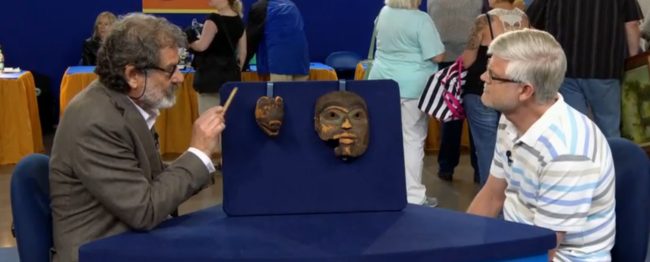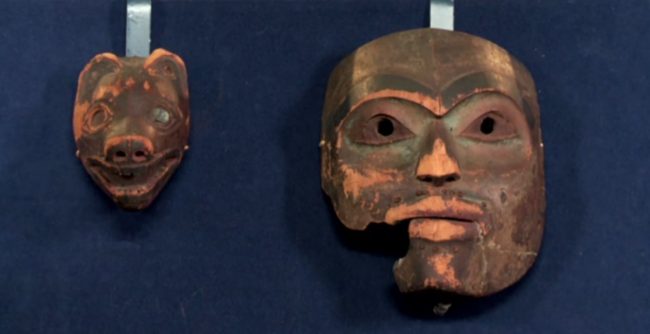
A recent episode of the popular PBS show “Antiques Roadshow” caught the attention of some Southeast residents when a couple of 200-year-old Tlingit masks from Haines appeared on screen.
It sparked the interests of regional Natives and historians and raised questions about how the items left the area.
Fans of Antiques Roadshow wait for those moments when an item on the program is valued at tens or hundreds of thousands of dollars. The TV cameras catch the owner’s stunned reaction when they hear their family heirloom is worth more than they imagined. That’s what happened recently during an episode of the show that was filmed in Bismarck, North Dakota.
“[It] would sell in the neighborhood of $175,000,” The appraiser, Tim Trotta said about one mask. The other he valued at $75,000. “This is really, really remarkable material. These are among the most rare objects in North America.”
But for some Alaska viewers the value wasn’t the surprise – it was the two items being appraised. They were wooden carved masks, in the Tlingit style, clearly old and according to the owner, originally from Haines.
PBS does not identify guests on the show. Calls to the public broadcaster were not returned so KHNS was not able to find the man’s name. But he did give one clue to his identity when he explained where the masks came from.
“They date back into the 1890s where my great-grandfather was a missionary to what is now called Haines, Alaska.”
Trotta, the appraiser, described the masks as a wolf and a face mask. He said there is a carving of a raven in the wolf’s ears and abalone was used for the wolf’s eyes. He said the face mask may depict an ancestor. He pointed out the faint pigments still visible. He estimated they were from the 1700s.

But local Natives and art experts say Trotta got a few details wrong. Those aren’t raven figures in the wolf’s ears, they’re eagles. The masks are likely from Klukwan, a native village about 20 miles north of Haines.
“When I look at them I see they are Tlingit sacred clan objects,” said Rosita Worl, director of Sealaska Heritage Institute in Juneau. “This belongs to Kaagwaataan of Haines. You’ve got a wolf and an eagle in the ear, so it’s got to belong to the Kaagwaataan there.”
Worl does agree the pieces are likely shamanic or tied to spiritual practices.
Helen Alten, who is the director of the Sheldon Museum in Haines, watched the online video of the show and said if they are that old, they would have had to been kept inside, perhaps in a covered grave. But she says they also appear worn and used.
“My thought was is that these were used in a cultural context,” Alten said. “That’s the kind of wear that I see in stuff that has been used in a cultural context over a long period of time.”
That brings up another point – how did the masks make their way into private hands, and to North Dakota? Using the clue from the guest about his great-grandfather having been a missionary here, the museum did a little research.
“From our research and our records, if his great-grandfather was here as a missionary in the 1890s for a decade the only person that could be is Pastor William Walter Warne and his wife Viola Bigford,” Alten said.
It’s difficult to say if the pieces were given as gifts or were collected. Alten says there are instances of pieces of spiritual value being gifted to missionaries if someone converted to Christianity.
“The other thing that has happened with Christianization, the missionaries were there to Christianize,” Alten said. “What happens is that with conversion people will give gifts like this of their old beliefs. Sometimes it’s part of the conversion is giving up the old. So, many missionaries acquired things as gifts.”
Worl says if that’s the case, the masks illustrate the ironic and difficult history of missionaries in the Chilkat Valley.
“What I find interesting is the contradictions,” she said. “The great-grandfather was a missionary and a teacher and at that time they were teaching Tlingit people our spiritual beliefs and practices were wrong. But at the same time he’s appropriating Tlingit objects. I like to quote Joe Hotch of Klukwan who said, ‘They collected our sins.’”
During an interview with PBS after the appraisal, the owner said he was shocked at the value, but didn’t plan on selling the items. He said they were important to his family.
Worl says Sealaska will try to contact the man if they can find out his identity. Since the items are now privately owned, she says they can’t be repatriated. That avenue is only available when items are held by federally funded institutions. But Worl still thinks the items should be returned.
“In this case if we could identify the individual we definitely would write to him and suggest he return them to the Tligint Kaagwaataan in Haines,” she said.
Alten says the Sheldon Museum is also interested in reaching out to the owner. She says the museum would work with the Jilkaat Kwaan Heritage Center in Klukwan to suggest the masks be donated back to the community or perhaps loaned so they could at least be displayed here.
It’s also possible Sealaska could work with other organizations to purchase the masks, if they ever come up for auction. But with the recent appraisal of a quarter-million dollars, that would be difficult.
